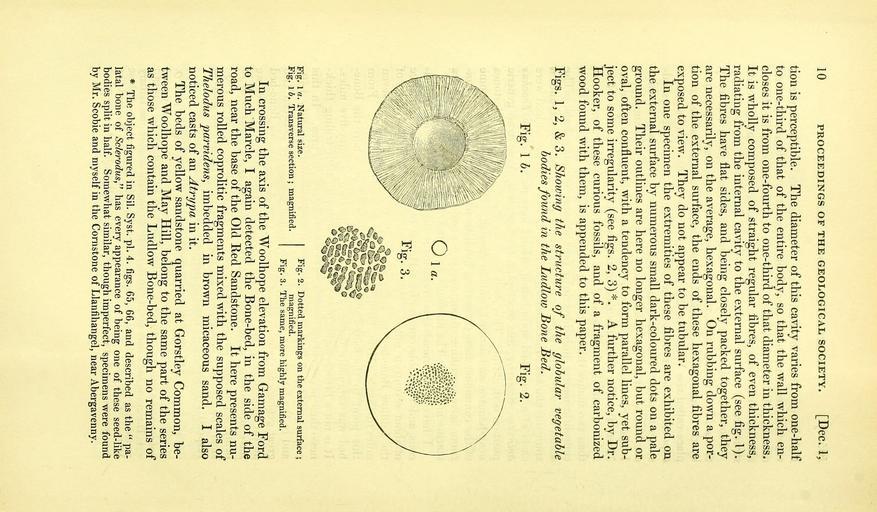MAKE A MEME
View Large Image

| View Original: | The_Quarterly_journal_of_the_Geological_Society_of_London_(12511870393).jpg (3200x1869) | |||
| Download: | Original | Medium | Small | Thumb |
| Courtesy of: | commons.wikimedia.org | More Like This | ||
| Keywords: The Quarterly journal of the Geological Society of London (12511870393).jpg 10 <br> PROCEEDINGS OF THE GEOLOGICAL SOCIETY DeC 1 <br> tion is perceptible The diameter of this canity varies from one-half <br> to one-third of that of the entire body so that the wall which en- <br> closes it is from one-fourth to one-third of that diameter in thickness <br> It is wholly composed of straight regular fibres of even thickness <br> radiating from the internal cavity to the external surface see fig 1 <br> The fibres have flat sides and being closely packed together they <br> are necessarily on the average hexagonal On rubbing down a por- <br> tion of the external surface the ends of these hexagonal fibres are <br> exposed to view They do not appear to be tubular <br> In one specimen the extremities of these fibres are exhibited on <br> the external surface by numerous small dark-coloured dots on a pale <br> ground Their outlines are here no longer hexagonal but round or <br> oval often confluent with a tendency to form parallel lines yet sub- <br> ject to some irregularity see figs 2 3 A further notice by Dr <br> Hooker of these curious fossils and of a fragment of carbonized <br> wood found with them is appended to this paper <br> Figs 1 2 3 Showing the structure of the globular vegetable <br> bodies found in the Ludlow Bone Bed <br> O <br> la <br> Fig 3 <br> Fig 1 a Natural size <br> Fig 1 b Transverse section ; magnified <br> Fig 2 Dotted markings on the external surface ; <br> magnified <br> Fig 3 The same more highly magnified <br> In crossing the axis of the Woolhope elevation from Gamage Ford <br> to Much Marcle I again detected the Bone-bed in the side of the <br> road near the base of the Old Red Sandstone It here presents nu- <br> merous rolled coprolitic fragments mixed with the supposed scales of <br> Thelodus parvidens imbedded in brown micaceous sand I also <br> noticed casts of an Atrypa in it <br> The beds of yellow sandstone quarried at Gorstley Common be- <br> tween Woolhope and May Hill belong to the same part of the series <br> as those which contain the Ludlow Bone-bed though no remains of <br> The object figured in Sil Syst pi 4 figs 65 66 and described as the pa- <br> latal bone of Sclerodus has every appearance of being one of these seed-like <br> bodies split in half Somewhat similar though imperfect specimens were found <br> by Mr Scobie and myself in the Cornstone of Llanfihangel near Abergavenny 34983101 108767 51125 Page 10 Text v 9 http //www biodiversitylibrary org/page/34983101 1853 Geological Society of London NameFound Atrypa NameConfirmed Atrypa NameBankID 4083726 NameFound Sclerodus NameConfirmed Sclerodus EOLID 13245196 NameBankID 4338947 NameFound Thelodus parvidens NameConfirmed Thelodus parvidens EOLID 13325393 NameBankID 5596951 Biodiversity Heritage Library The Quarterly journal of the Geological Society of London v 9 1853 Geology Periodicals Smithsonian Libraries bhl page 34983101 dc identifier http //biodiversitylibrary org/page/34983101 smithsonian libraries Information field Flickr posted date ISOdate 2014-02-14 Check categories 2015 August 26 CC-BY-2 0 BioDivLibrary https //flickr com/photos/61021753 N02/12511870393 2015-08-27 09 56 50 cc-by-2 0 PD-old-70-1923 The Quarterly journal of the Geological Society of London 1853 Photos uploaded from Flickr by Fæ using a script | ||||